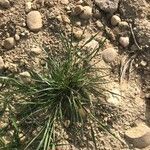Tufted annual, 50-250 mm high. Leaf blade up to 10-50 x 1.5 mm, involute; ligule a fringe of hairs. Inflorescence a panicle, 10-50 mm long. Spikelet 4-7 x 1.5 mm, narrowly lanceolate, mostly light green, sometimes purple; glumes ± equal, shorter than to as long as spikelet, 5-7-nerved. Florets 5-10; lemma 7-9-nerved, back pubescent, hairs 0.2-0.5 mm long and often club-shaped, lobes obtuse; short mucro of < 1 mm long arising from sinus or absent; anther 0.2-0.4 mm long. Flowering time June-Dec.
Plants annual. Culms 10–30 cm high. Leaves glabrous. Inflorescences linear-lanceolate, 10–60 mm long. Spikelets 4.2–6 mm long, with 4–7 florets. Glumes shorter than or equalling florets; lower glume 3.7–4.7 mm long. Lemma: body 1.25–1.6 mm long, villous, with indumentum distributed overall; lobes 0–0.25 mm long, obtuse, partially fused or not fused to awn; awn sometimes present, often short or absent. Palea obovate, 1.2–1.5 mm long. Anthers 0.25–0.4 mm long. Caryopsis 0.52–0.8 mm long.
Annual, up to 250 mm tall. Leaves linear, rolled; ligule a fringed membrane or a fimbriate, unfringed membrane. Inflorescence a compact panicle. Spikelets 4-7 mm; long, narrowly lanceolate, 5-10-flowered; glumes ± equal, scabrid, shorter to longer than spikelet, 5-7-nerved; lemmas rounded, lobed or shallowly notched, backs pubescent with club-shaped hairs, hairs 0.2-0.5 mm long, mucro up to 1 mm long present or absent, 7-9-nerved; anthers 0.2-0.4 mm long.
Annual; up to 0.25 m high; tufted. Leaf blades up to 10-50 x 1.5 mm; rarely longer; involute. Flowers: panicle contracted; 10-50 mm long; spikelets 4-7 x 1.5 mm; spikelets 5-10-flowered; usually light green; sometimes purple; often long and narrowly lanceolate; glumes usually closed; lemma backs pubescent; hairs usually club-shaped; lobes obtuse; with or without a short (< 1 mm long) mucro arising from sinus.
Tufted annual 50-250 mm high. Leaf blade 10-50 x to 1.5 mm, involute. Inflorescence 10-50 mm long. Spikelet 4-7 x 1.5 mm, narrowly lanceolate, mostly light green, sometimes purple; 5-10-flowered; lemma pubescent, hairs 0.2-0.5 mm long and usually club-shaped, lobes obtuse, distinct, a short mucro of less than 1 mm long present between lobes in sinus or absent; anther 0.2-0.4 mm long.
Annual to 25 cm. Leaves linear, rolled. Spikelets narrowly lanceolate, 5-10-flowered, in a compact panicle, lemma backs pubescent with club-shaped hairs, mucro to 1 mm.

